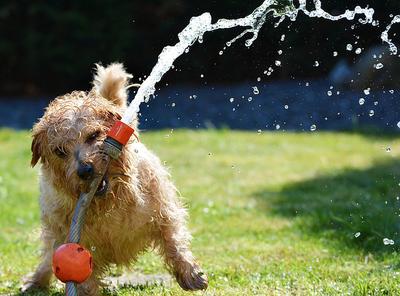by Larry
(UK)

Use Your Water Wisely
Many of us will have great memories of expanses of soft green grass, an idyllic place for playing baseball and games of hide and seek, having picnics, or just soaking up the sun.
But as environmental awareness grows, the world is realizing that while lawns might be useful and beautiful, they are not always sustainable — especially if you live in an area of water scarcity.
Infact, almost 9 billion gallons of water a day are used to water lawns and gardens, and half of that water ends up wasted because of evaporation and runoff, according to the Environmental Protection Agency (EPA). Not only that, but while soft grass might feel heavenly on your bare feet, it provides very few habitats for the animals and plants that make up a healthy ecosystem.
Thankfully, manicured turf grass lawn is not the only ground cover available. Other possibilities exist that can offer a place for recreation and relaxation, save water, and also create a healthy habitat for local wildlife — without compromising on visual appeal.
Most drought-friendly lawn alternatives rely on a mixture of hardscaping and xeriscaping.
Hardscaping
The word hardscaping conjures up images of a great expanse of grey tarmac, concrete, or uninspired gravel.
But hardscaping —- which simply refers to hard landscape materials — offers the opportunity for experimentation and creativity. Instead of using generic materials, like run of the mill pavers or granite stones, you can look to nature and other cultures for inspiration.
Spanish pavers are a popular colourful hardscape option for patios in yards of Mediterranean-style homes.
Natural stone features can make a striking setting for your home. Go Japanese style and replace the lawn with gravel in a nod to the zen tradition, or follow ancient greek style and arrange your pavers in the design of an astrological sundial,.
The advantage of gravel as hardscape is that its free draining, letting water sift through to absorb into the earth, unlike pavers which can sometimes cause lots of run off during heavy rainfall.
Rubber Mats make a good option for hardscape if you have kids around. They can make play areas much safer, limit weed growth, and reduce the need for irrigation. Make sure to opt for recycled rubber for maximum environmental benefit.
Xeriscaping
Instead of relying entirely on hard surfaces, you can use xeriscaping techniques to introduce soft edges to your drought-friendly lawn.
Xeriscaping is simply landscaping with low water requirements. This tends to uses drought-tolerant decorative plants, and is particularly appropiate In hot, dry areas like the southwest United States.
Ideally you would include mostly native plants that naturally thrive in arid environments. To see what plants grow naturally near your home, simply take a walk in a local natural area, or ask experts at a local plant nursery to help you identify species.
Here are some of the different categories of plants that you might consider:
Ornamental grasses look great on the edge of hardscaped areas. Many of these are naturally drought-resistant and low-maintenance, and require no fertilisers of pesticides. Plant several of the same species together in a drift for a striking visual effect when the wind blows. To prevent grasses falling over onto flat areas, plant taller grasses at the back and shorter ones at the front of the border.
Mosses can provide an easy, low-maintenance alternative to grass for large areas of ground in the shade. As moss grows very little, you will never have to mow it, and will not have to water it unless you live in a very arid climate. There are dozens of different mosses available, all with different textures, appearances, and thicknesses. Choose a hardier variety if the area will have foot traffic, or combine several species for visual interest.
Low growing groundcovers provide a less thirsty alternative to grass. Many of these species will spread quickly across the ground, without growing tall enough to require mowing — ideal for filling in large areas and preventing weed growth.
Ultimately the local climate will determine which species are most appropiate for you, but clovers, thymes, and other species like Lilyturf can all spread out to form a lush, grass-like covering.
If you are in a very dry area, you might consider using sedums. These provide a living carpet in dry sunny areas where other plants struggle.
If you are feeling creative, you could even combine several different species to create a mosaic of living plants.
So what are you waiting for? Time to get rid of that thirsty lawn and conserve both water and money with a drought-friendly lawn replacement.
Author Bio:
Lawn care enthusiast Laurence Bennet believes that sustainable gardening should play a key role in tackling global environmental challenges. Visit his site at Lawn Mower Larry for everything on lawns and mowers.


